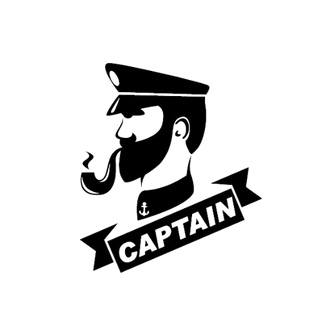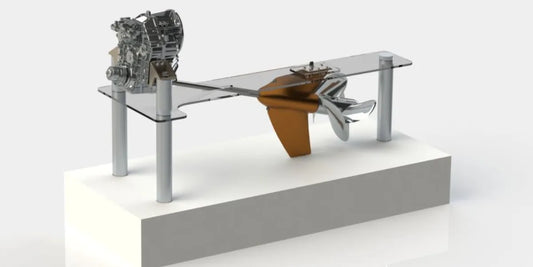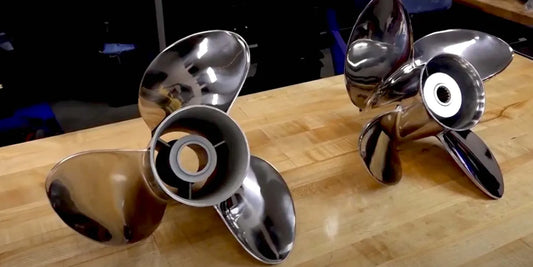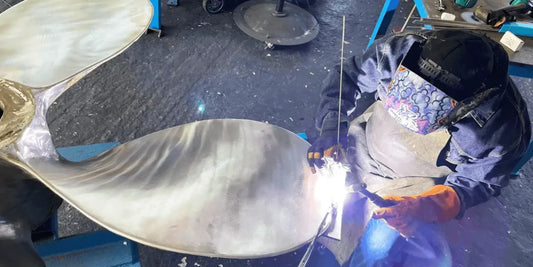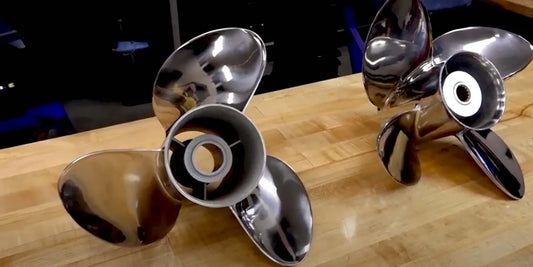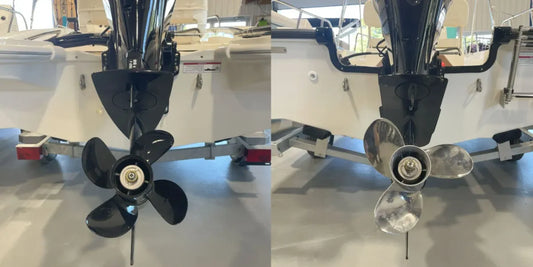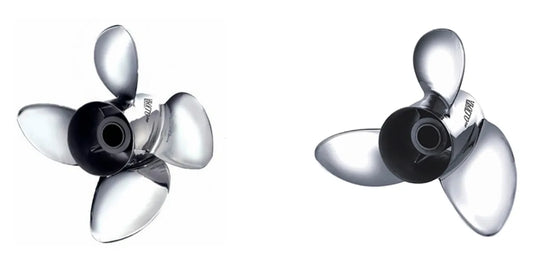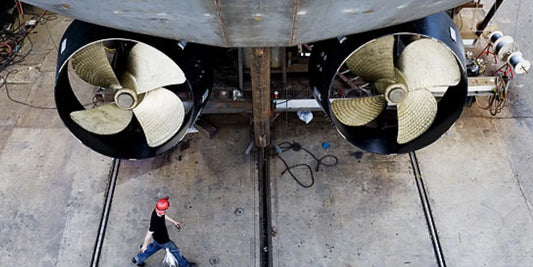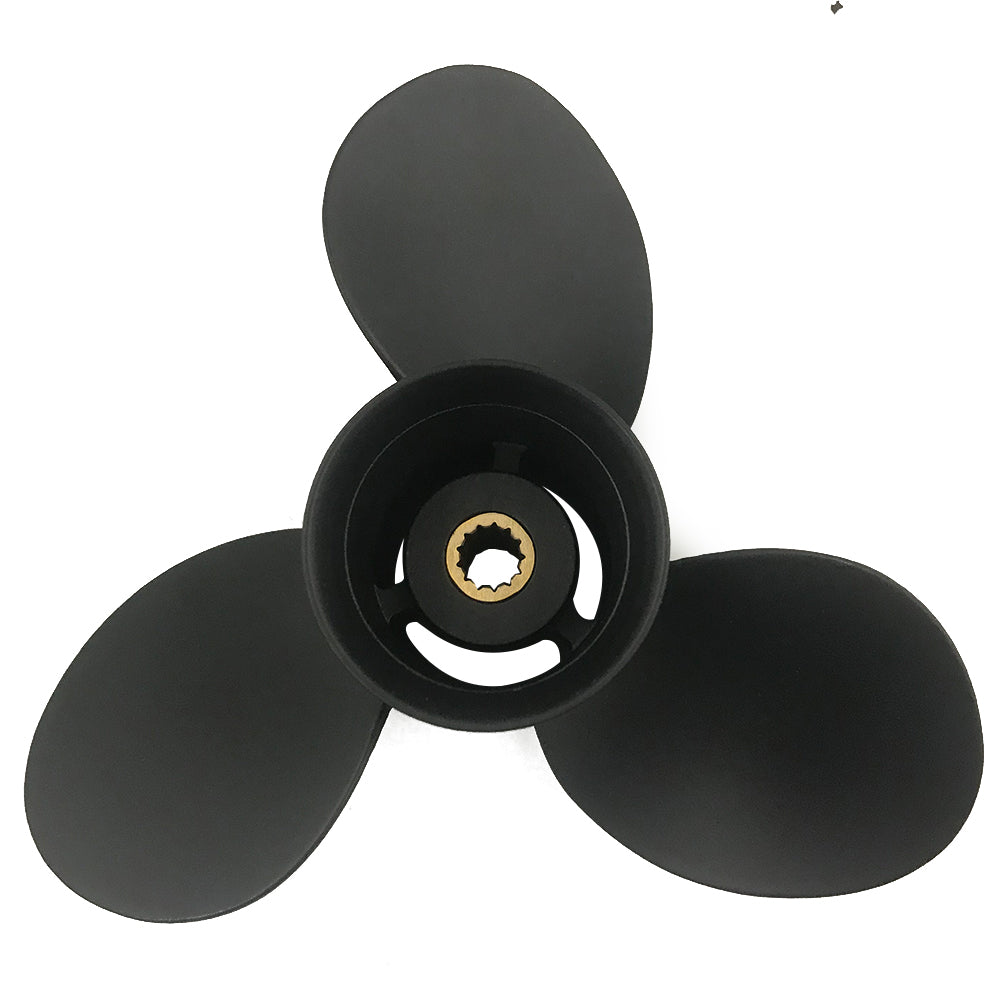A spun prop hub is typically a source of frustration for boat owners, due to its negative impact on performance and the uncertainty surrounding its diagnosis. When the engine revs but does not provide thrust or speed, a spun prop hub should be among the suspects. Knowing the signs, causes, and visual indicators for such damage will save much-needed money on repairs and precious time away from cruising. Here, we guide you through the entire process, enabling you to identify spun prop hub symptoms and acquire the knowledge to treat the issue properly. Read on to uncover some essential pointers, tips, and steps for ensuring a completely smooth flow.
Understanding the Spun Prop Hub

Definition of a Spun Prop Hub
A spun prop hub arises when the inner bushing of a propeller hub, usually made of rubber, loses its bond from the metallic casing enveloping it. This failure prevents the propeller from efficiently transmitting power from the engine to the water, thus reducing propulsion or eliminating thrust. Most of the time, wear out, sudden strikes against an underwater obstacle, or extended overloading of the propeller are behind the cause. Nowadays, the prop hubs are constructed in a manner that would render partial functionality should a problem fail; however, repairing the problem as fast as possible is paramount for avoiding any further damage to the drivetrain of the engine. Spotting a spun hub can save a considerable amount of repair costs and keep performance at its peak on the water.
Visual Symptoms of a Spun Propeller Hub
Early recognition of this failure can prevent further damage and costly repairs. The primary visual symptom is a drop in performance, characterized by a decrease in speed or power while the engine RPM remains constant. Blackened or melted rubber residues near the hub area could indicate excessive friction and heat inside the hub components. Removal of the propeller will permit scrutiny of the hub for signs of wear, such as cracks, deformation, or uneven surfaces, that will confirm failure.
Engine over-revving without corresponding propeller movement occurs mainly because the hub is slipping internally. Water sports enthusiasts or boaters may find that thrust is variably applied, especially under heavy loads or during sudden accelerations. Strange noises-whether somewhat grinding or slipping-are a good indicator that you have a spun hub. Visual inspections and awareness of any unusual boat performance clues are primary steps toward ensuring safety and functionality on the water.
Common Symptoms of a Spun Prop
Common symptoms of a spun prop that present decreased performance level and unexpected challenges on the water:
Reduced Speed and Power:One very important symptom is a sudden reduction in speed or power output, while the engine appears to be revving normally. Since the thrust from the motor is not being properly transmitted to the propeller, this occurs.
Engine Over-Revving: If the engine's revs light up without an accompanying increase in speed for the boat, you may be looking at a spun hub. Such an anomaly tells that there is a loss of grip between the propeller and its hub.
Difficulty in Maintaining Thrust: Acceleration or steady speed with difficulty in maintaining thrust is one definite symptom of a spun prop. It becomes pretty apparent when there are heavy loads or sudden jerky maneuvers.
Vibrations or Rough Operation: These vibrating irregularities can be felt, or rough handling can occur with the motorboat, all due to a damaged or spun hub, which prevents a smooth journey.
Visible damage to the propeller hub: During inspection, signs such as burnt rubber, misalignment, or wear marks on the hub can indicate a spun prop. Often these visual clues are correlated with the above mechanical symptoms.
Seeing these symptoms earlier is of critical importance. Fixing the issue at once can enhance performance and ensure the safety of your vessel and its passengers in water. Repairs or replacements should always be undertaken by a professional to guarantee 100% functionality.
Causes of a Spun Propeller

Mechanical failures leading to hub spin
A hub spin usually occurs due to one or several mechanical failures. One of the most important causes is wear from prolonged use or improper maintenance of a rubber hub insert. Over time, the material tends to lose its grip, making it less efficient at transmitting torque. Heavy-impact situations, such as an encounter with submerged debris or grounding on sand, can produce a sudden stress that exceeds the design load of the hub, causing the interface between the hub and propeller shaft to slip.
Material deformation caused by overheating on the hub assemblage due to a high coefficient of friction or poor ventilation may lead to compromising of the structural integrity of the hub. Loose and/or corroded components, such as splines or couplings, can facilitate slippage by diminishing the mechanical connection between the propeller and the shaft. An inspection should be regularly held to contain these issues in tandem with maintenance to maintain the lifespan of the propeller system. Good maintenance should entail keeping all mating parts free of contaminants, ensuring they are adequately aligned, and operating within the torque and load limits set forth by the manufacturer to minimize mechanical hazards.
Improper Installation Issues and Maintenance
Improper installation or poor maintenance can worsen existing problems to such an extent as to become an inefficient, wearing, and degrading factor leading to total system failure. If the installation does not conform to the manufacturer's specifications, torque is applied to a coupling bolt or bolts, instead of an accepted figure for a particular application. As a result, the propeller shaft is not aligned correctly, and stresses are imposed upon the shaft and propeller assembly (Figure 2.7). This stress will cause vibrations in time, uneven wear, or accommodate cracks; thereby reducing performance or sometimes even becoming a hazard.
Conversely, improper maintenance abrades the life of any system. Corrosion, loose fittings, or degradation may be early signs of an issue and their discovery and remedy during inspection can prevent a list of extensive and costly repairs. A proactive maintenance program becomes crucial in sustaining the operational efficiency of the system, while ensuring periodic inspections, accurate alignment checks, and regular cleaning of components will minimize unforeseen downtime.
Environmental Factors Affecting Prop Performance
Propeller performance and environmental conditions are inextricably linked, as the latter significantly impact efficiency, durability, and overall reliability. As for some of the influencing factors, water salinity, temperature changes, and marine growth contribute heavily to setting performance parameters. As a case in point, corrosion is exacerbated by saline water in and around metallic materials for propellers, with a gradual compromise of structural integrity. Temperature variations may create stress in materials, causing uneven wear and tear in some areas, particularly in regions where seasonal changes are extreme.
Construed by unnatural forces: marine growth, such as algae, barnacles, or biofouling, creates a drag that diminishes thrust efficiency. Scientists have demonstrated that even the thinnest biofilm layer can reduce a ship's propulsion efficiency by 5-10%, thereby increasing fuel consumption and operating costs. Periodic maintenance and the application of antifouling coating become the chief means to offset these mechanisms. On the other hand, advancements in propeller materials, such as the use of composite materials that resist corrosion and growth accumulation, now offer new solutions to the propeller's enemies in environmental conditions, coupled with long-term performance.
Diagnosing a Spun Prop Hub

Step-by-Step Forensic Diagnosis
Initial Visual Inspection: Inspect the propeller and hub visually for signs of damage, such as cracks, warping, or excessive wear. Watch out for the rubber hub insert, as slippage may occur or wear may affect performance.
Mark & Rotate Test: Draw a line across the hub and propeller with a marker. Run the engine under load for a short time and verify the mark. If the marks on the hub and propeller no longer line up, it is evident that the hub has spun.
Engine Over-Revving Symptoms: Notice the engine RPMs under load. When the prop hub is spun, RPMs often suddenly start to increase without a corresponding increase in actual boat speed, indicating that the propeller is not efficiently transferring power.
Detecting Excessive Vibration: An unbalanced hub may lead to uneven power transmission, resulting in unusual vibrations or shuddering during operation. When this symptom appears, the matter must be investigated further to confirm that it is indeed in working order.
Confirming the Hub with a Propeller Tester: Use an exclusive propeller testing instrument or bench test setup to check the strength of the hub under simulated conditions. This testing may show internal slippage that is not visible from preliminary visual inspections.
Checking for Other Causes: Before concluding that the hub is the cause of the trouble, check the driveshaft, propeller blades, and gearbox, as damage or faults in these components may also cause similar symptoms.
When this comprehensive diagnostic procedure is followed, you can accurately identify possible prop hub deficiencies from other mechanical issues, saving a great deal of precious time and effort, and ensuring that the proper corrective measures are applied effectively.
Tools To Consider for an Accurate Diagnosis
The accurate diagnosis of the various problems that could affect the prop hub requires a proper set of diagnostic equipment; these specialized tools interspersed with some fundamental measuring applications must be able to detect the fault with precision. Here is a list of tools to equip yourself with for diagnosis:
Torque Wrench - This tool should be used to maintain proper torque levels and bolt or nut tightening, which will help identify any alignment or torque-related issues.
Depth gauge - Helps you evaluate the depth of propeller cuts or grooves to assess the level of wear or damage.
Dial Indicator - Useful in checking any misalignments or deformation on the prop hub or shaft.
Inspection Mirror: A small but handy tool for visually inspecting difficult areas for traces of cracks or other imperfections.
Handheld infrared thermometer - Will detect unusual heat levels around the hub, possibly generated by abnormal friction or internal damage.
Multimeter - Checks for electrical continuity to eliminate any probable issues in electronic components associated with the hub.
Propeller Puller - Allows for easy removal of the propeller with no additional stresses or damage caused in the process.
High-intensity Flashlight - Used for an intense glare on the surface of the hub, or whatever part is under review, to catch the very slightest of faults.
Having these tools in your hands will be vital in accelerating the diagnostic processes, consequently enabling you to obtain suitable and reliable results that have almost zero impact on the mechanical problems at hand. Therefore, having such tools increases your capability to conduct a refined and professional-level evaluation.
When to Seek a Professional Intervention
While many mechanical inspections and repairs can be carried out with the right tools and knowledge, others do, however, merit professional intervention. Strange noises, persistent vibrations, or severe wear not detected by conventional troubleshooting constitute clear signs of the need for assistance. Also, in the case of structural damage like cracks or misalignment in critical components, such damage is assessed and rectified only with special tools and expertise.
Advanced diagnostic equipment, like laser alignment tools and ultrasonic testers, is possessed by practitioners to detect detailed flaws, which could otherwise be considered insignificant or imperceptible during manual checks. High-level calibers and testing of sophisticated mechanical assembly are often required after a repair to redeem long-term surety and good-performance aptitude. A delay in expert evaluation will not only exacerbate the problem but may also pose a safety risk and ultimately escalate repair costs. Safety and performance come first; therefore, know when to refer the job to certified experts for thorough diagnosis and specific repair.
Fixing a Spun Prop Hub

DIY Fixes for Minor Damage
A few cheap and easy solutions may be carried out on minor damage to the spun prop hub before calling in the experts. To start, examine the prop hub thoroughly, looking for obvious signs of wear such as cracks, bends, or abrasions. Sanding down smaller surface imperfections with very fine-grit sandpaper will prevent further damage and allow for smoother operation of the prop. When the damage involves loosening of parts, tighten the bolts and nuts fully but not beyond reason, as this would generate stress cracks. An additional application of a good-grade marine adhesive will help in regaining some structural integrity when the damage involves small separations.
Do keep in mind that these fixes should be reserved for temporary repairs or non-essential matters. Regular maintenance, such as lubricating moving parts and cleaning debris after use, helps extend the lifespan of the prop hub, thereby limiting instances of recurring damage. Always test the component's functionality after any repairs to confirm its safe and efficient operation.
Professional Repair Options and Their Corresponding Costs
Suppose professional attention is required for the prop hub. In that case, various repair alternatives can be pursued, each with a different cost depending on the extent of the damage and the materials used. Typically, professional repair services conduct inspections, realignments, and replacements of parts, and sometimes fabricate custom components for damaged parts.
Minor Repairs: Most professional technicians charge between $50 and $100 for minor problems, such as dents, scratches, or imbalances. They usually offer cleaning and basic balancing of the prop hub as well as some cosmetic repairs to limit further damage and keep the props working smoothly.
Moderate Repairs: If the damage to the prop hub is more severe, such as bent blades or partially broken parts, repair costs may range from $150$ to $300. This sort of repair may include straightening out pieces of the structure, welding, or even partial replacement of the hub. Material costs also influence the amount charged, whether for aluminum or stainless steel.
Complete Overhauls: Severe damage that affects the structural integrity of the entire prop hub usually requires an overhaul and replacement. It may cost anywhere from $500 to $1,000 in repairs and includes labor and materials. For special equipment or high-performance hub applications, the costs increase significantly due to the precision engineering and custom part requirements.
Additional Factors Influencing Costs: Other factors that affect the total cost of repair include labor rates in your locality, the type of equipment used, and whether you prefer expedited repairs. OEM parts tend to be a little more expensive but guarantee compatibility and quality.
Professional services can further help extend prop-hub life and maintain safety and efficiency, especially for critical components. The client should obtain detailed repair estimates, and various options for warranty coverage should be explored to manage and reduce repair costs effectively.
Replacing a Spun Propeller Hub: What You Need to Know
This is a crucial activity best performed by a person with both technical knowledge and keen observation skills. A spun hub occurs when the rubber portion inside the hub mechanism loses its grip, causing propulsion inefficiencies. This slip is usually observed directly by the loss of performance, making it hard to attain acceleration. Initial removal of the propeller must be done with care to avoid damaging the propeller shaft or the seal. For this, one may require a propeller wrench and gear lubricant. Besides checking the spline and the drive pin for wear and damage, one should fit the new hub.
A key step in the replacement process is ensuring that the new propeller hub matches the specifications of your engine. Its compatibility is critical because a mismatched hub will cause poor performance and possibly further mechanical issues. OEM hubs are highly recommended because of their exact fit and adherence to all of the manufacturer's standards, although they tend to be somewhat more expensive. Many of today's hubs are also built to newer standards, with, say, new rubber compounds or advanced slip reduction designs. These contribute towards longevity and performance improvements in comparison with older types.
Cost considerations should also factor into the decision-making process. Professional services are often preferred for their expertise. Still, when it comes to replacing a spun hub, this task can sometimes be achieved by experienced individuals with a propeller hub repair kit. Researching prices, warranty options, and discounts can help reduce the costs of parts and labor. DIY replacement or professional replacement --- whichever the case may be, adhering to proper installation and maintenance procedures will ensure the long-term reliability and best performance of the propeller in varying water conditions.
Preventing Future Spun Prop Issues

Maintenance Regular Tips for Propeller Hubs
Good maintenance of propeller hubs prevents future spun propeller issues and allows the propeller to function well for an extended period. Always inspect the hub for irregularities or conditions that may impair its operation, such as cracks, corrosion, or loose fittings. Following every use, clean the propeller hub thoroughly, especially if operating in saltwater, as the salt can encourage corrosion or attract debris accumulation. An additional method is to apply a protective coating or lubricant, which can significantly minimize friction and environmental damage.
Opening the installation torque levels for investigation should be considered a matter of inspection, since if the hub is subject to being overtightened or undertightened, it will stress the mechanism unevenly, hence encouraging failure. Additionally, marine-grade hardware of high quality should be used to enhance durability and ensure compatibility with your specific engine model.
Replacing major components like the rubber bushing inside the hub at periods recommended by the manufacturer increases safety even further. Keeping track of all maintenance and working to an exact maintenance schedule should assist you in identifying potential problems at an early stage. When these maintenance steps are integrated into your preventive measures, the lifespan of your propeller hub can be significantly extended, thereby avoiding costly repairs.
Choosing the Right Spare Prop and Hub Kit
The selection of spare propeller and hub kits always starts with a consideration of engine specifications and the boat's application. To ensure optimal performance and fuel efficiency, I have to check that the size, pitch, and material of the propeller correspond to the particular engine that I have. Also considered by me are the conditions in which I typically operate the boat, as these determine whether the propeller will be of a particular design for calm lakes, rough seas, or towing loads. Proper matching of the kit under the appropriate conditions will undoubtedly ensure smooth functioning and durability.
The grade and integrity of the hub kit components remain a key factor for me. I tend to opt for kits that feature sturdy materials, such as stainless steel or high-grade aluminum, which are capable of withstanding wear and corrosion over time. I also tend to consider manufacturers with a recognized reputation for quality and compatibility. I base my choices on reviews and trusted recommendations to ensure that the spare prop and hub kit will not let me down in my hour of need.
I always think in terms of easy installation and maintenance. I want the kit to come with clear instructions and all the necessary accessories to make my life simpler. A reliable spare set affords me peace of mind, knowing that I am well-prepared against unforeseen and tricky situations on the water. By paying attention to these details, I am confident in my spare prop and hub kit choice, keeping my boat working efficiently and safely.
The Upgrade to Improve Propeller Performance
One of the few things that I have seen to improve a boat's performance and efficiency definitely is upgrading the propeller, selecting the one that best matches my specific boat type and service conditions so that I may gain some speed, plus fuel economy and handling. Stainless steel has worked wonders for me as a prop; it's stronger and performs better than the aluminum ones. Significant upgrades let me tailor the boating experience to faster acceleration, higher top speed, or towing.
Another crucial upgrade I always consider is the pitch and diameter of the propeller, especially if they fit the engine specs on my boat. I have come to realize that small changes really make a big impact: for example, lower-pitch props will accelerate faster and are good for heavier loads, whereas higher-pitch props will help me go faster in open water conditions. Cupping and rake angles are also considered, as they may affect my boat's performance in different water conditions.
Generally, regular propeller upgrades and a careful selection of types have kept my boat performing at peak levels and reducing wear and tear on the engine over time. Through keeping up with all the new happenings in the industry and periodically reassessing what my needs are, I have found smoother rides, better fuel efficiency, and just a much more pleasurable overall boating experience.
Reference Sources
- How to Diagnose and Deal with a Spun Hub? - Mercury Marine
- Characteristics of a Spun Prop Hub? - The Hull Truth Forum
- Guide to Spun Props - Michigan Wheel Blog
- Learn How To Easily Diagnose A Spun Propeller Hub - ShrimpNFish Florida
- What Causes a Spun Prop Hub? - Boating Magazine
Frequently Asked Questions (FAQs)
What Does a Spun Prop Hub Look Like?
A widespread description of a spun prop hub is a propeller that is loosely coupled to the prop shaft, causing it to slip during engine speed changes. This slip results in the propeller not absorbing power adequately, not permitting it to be accelerated in the right manner to an engine RPM that otherwise would have been achievable. At the least, such excessive movement causes undue wear and tear or damage to the back of the prop. There might also be a slight separation between the outer and inner hubs of the prop, indicating that the rubber bushing inside has gone bad. During the inspection process, a misalignment of the prop to the drive shaft can be noticed due to the spun prop hub. Within some cases, the owners may find that the blades of their props are not truly doing what they were supposed to do-that is, the poor performance.
What Causes a Spun Prop?
The spinning of the propeller is often caused by torque or shearing forces that exceed design limits. A propeller may catch water vapor or cavitate, or an engine may be spun at specific rpms without an appropriate load being put on it. Further, the propeller might spin in the hub if the rubber bushing has worn out and was not replaced along with the propeller and hub. This usually happens due to poor lubrication over the years. At times, an improperly installed prop or hub will bring on the problem too. Knowing the causes will help the boater avoid encountering the issue by ensuring proper installation and inspection of the prop systems.
How do you fix a spun prop?
Usually, a spun prop will require the hub to be replaced with a new one. Remove the prop from the shaft to check for wear on the inner and outer portions of the hub. If the hub had spun, it is now essential to ensure that the new prop is correctly aligned and installed. From here on, depending on your engine, you may need to press the new hub securely onto the propeller. Also, check the prop shaft for cleanliness and any damage. If you do not feel comfortable attempting the repairs at home, a professional should be able to assist you at a local prop shop through to the finishing stages.
How to Diagnose a Spun Hub?
The first step in diagnosing a spun hub is observing how the boat performs while it is in operation. If the engine revs up and the boat does not accelerate as expected, then there could be a spun hub. A spun hub could be accompanied by strange vibrations or sounds from the propeller area. Look at the propeller blades for any damages or possibly uneven wear that could signify a hub problem. Draw a line on the prop shaft and observe if the shaft moves while running; if so, the hub might be damaged. Lastly, consulting a boating forum or talking with other boat owners can provide some insight into similar incidents and how to solve them.
What Does a Good Prop Hub Look Like?
An inadequate prop hub must be kept loosely fitted while slips or wear can be seen. When checking newer hub materials, look for a clean, smooth surface with no signs of cracking or deformation. Inside the hub, the rubber bushing should remain intact, with no deterioration allowed, so that the propeller connects directly to the drivetrain. The propeller blades should be evenly formed, with no bends or chips that could affect performance. A well-maintained hub and prop system should allow smooth operation and efficient acceleration; working your way with regular checks and maintenance will ever keep your prop hub in good condition.
How to Get a New Prop and Hub?
The installation of a new prop and hub begins by identifying the proper specifications to suit your outboard and boat. Besides diameter, pitch, and material, all should be researched appropriately for their effects on the performance of the propeller to be purchased. Visit local marine supply stores or a prop shop to check out the selections. Also, many manufacturers, including Michigan Wheel, make spare prop and hub kits that provide everything necessary for installation. However, it is always best to interact with knowledgeable individuals at the point of purchase to ensure you get precisely what fits your boating needs. Once you have your prop and hub, you may proceed to install them by following the instructions, or request assistance from a professional for perfect fit and functioning.
What Is the Function of the Propeller Hub?
Few components constitute the hib in watercraft. The hub connects a propeller to the prop shaft, allowing the propeller to accept power from the engine and propel the boat through the water. Designed to shock absorb and dampen vibrations, the propeller hub averts jarring in the ship. It also functions to keep propeller blades in alignment while in operation, which requires maintenance to attain perfect operating conditions. When all is well with the hub, curtailment of gripping power would result in the load causing the prop to spin freely. Efficiency drops when the hub fails or wears out; consequently, the propeller may even incur damage, further aggravating the situation, and so will the motor. Inspections and maintenance of the propeller hub must be carried out at a frequency that provides reliable service while the vessel is in operation.
How to Identify Signs of a Failed Hub?
Spotting symptoms of a failed hub can spare boat owners from suffering additional damage and having to bear the expense of repairs. Symptoms to watch out for could involve abnormal vibrations, noise emanating from the prop area, or an evident lack of acceleration while the engine revs. Should the propeller seem out of alignment or if there's excessive play on the hub at inspection, these are all telltale signs of failure. If you see any cracking or wear on the rubber bushing inside the hub, it may be time for a full replacement. Conduct these checks routinely as part of your maintenance work to spot these signs ahead of time and enjoy a stress-free boating experience.
